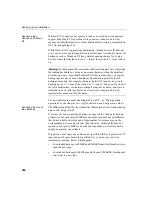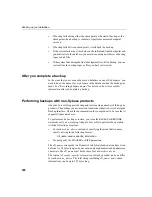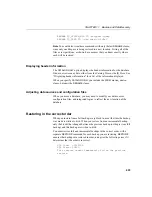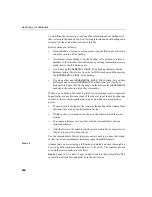
Restoring your databases
400
Just as for backup, each archive_device specifies the API (Sybase or third
party) and, for the Sybase API, the physical tape device or disk file name from
which you are restoring. For third-party APIs, the content of the
archive_device string depends on your vendor. The archive device must not be
a raw disk device. When you restore from disk files using the Sybase API, you
must supply the same number of archive devices as were specified when this
backup was created.
Warning!
If you misspell a tape device name and give a name that is not a valid
tape device on your system,
RESTORE
assumes it is a disk file and tries to read
from it.
See “Specifying archive devices” for details on specifying devices.
Note
If you are restoring from tape devices on Windows NT, note that you do
not need to redouble the backslashes when you specify tape devices for restore,
as you did for backup.
Example 1 —
Restoring to the same
location
This Windows NT example restores a database to asiquser.db. The database is
restored from two disk files. All database files will be restored to their original
locations.
RESTORE DATABASE ’asiquser.db’
FROM ’c:\\asiq\\backup1’
FROM ’c:\\asiq\\backup2’
Moving database files
If you need to move database files to a new location—for example, if one of
your disk drives fails—you use one of the following methods:
•
To move the database file that holds the Catalog Store (by default, the .db
file), you simply specify the new name as db_file.
•
To move or rename the transaction log file, you use the Transaction Log
utility (
DBLOG
). For syntax and details, see “The DBLOG command-line
utility” on page 405.
Summary of Contents for Adaptive Server IQ 12.4.2
Page 1: ...Administration and Performance Guide Adaptive Server IQ 12 4 2 ...
Page 16: ...xvi ...
Page 20: ...Related documents xx ...
Page 40: ...Compatibility with earlier versions 20 ...
Page 118: ...Troubleshooting startup shutdown and connections 98 ...
Page 248: ...Importing data by replication 228 ...
Page 306: ...Integrity rules in the system tables 286 ...
Page 334: ...Cursors in transactions 314 ...
Page 396: ...Users and permissions in the system tables 376 ...
Page 438: ...Determining your data backup and recovery strategy 418 ...
Page 484: ...Network performance 464 ...
Page 500: ...System utilities to monitor CPU use 480 ...
Page 514: ...Characteristics of Open Client and jConnect connections 494 ...
Page 536: ...Index 516 ...
















































